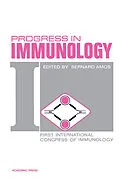Progress in Immunology: First International Congress of Immunology is a collection of papers and summaries of the workshops conducted at the First International Congress of Immunology. The proceedings review significant advances that have been made in the field of immunology and covers topics ranging from the structure and genetics of antibodies to lymphocyte membranes and the role of antibodies and complexes in immune tissue damage. Cell cooperation in the immune response is also examined.
This volume is organized into 15 sections and begins with a discussion on the structure of immunoglobulins and results of experiments which support the domain hypothesis and the evolution of immunoglobulins by gene duplication, along with the presence of genetic markers in V regions. The reader is then introduced to expansion and contraction in the evolution of immunoglobulin gene pools; receptors for C3 on B lymphocytes and their possible role in the immune response; and subpopulations of thymus cells and thymus-derived lymphocytes. Tne remaining sections focus on effector mechahisms of cell-mediated immunity; genetic control of immune responsiveness; immune disorders in humans such as glomerulonephritis and rheumatoid arthritis; and viruses involved in immunopathology.
This book is dedicated to immunologists.
Inhalt
List of Contributors
Preface
I The Structure and Genetics of Antibodies
Immunoglobulin Structure: Diversity, Gene Duplication, and Domains
Ammo Acid Sequence of the y Chain of He
Evolution by Gene Duplication
The Domain Hypothesis
The Nature of Immunoglobulin Diversity
Translocation and the Origin of Diversity
References
Three-Dimensional Structure of Immunoglobulins
Experimental
Results
References
Expansion and Contraction in the Evolution of Immunoglobulin Gene Pools
IgG Subclasses
Basic Sequences and Variable Genes
Nonrandom Mutation and Selection
References
Structural Localization, Allelic Exclusion, and Linkage Relationships of Rabbit Allotypes
Introduction
Regions of Rabbit Immunoglobulins and Location of Genetic Markers
Allelic Exclusion
Linkage Relationships
References
Genetic Control of the Biosynthesis of IgG and IgM
I. Introduction
II. Individual Antigenic Specificities in Til IgG and IgM
III. Amino Acid Sequences
IV. Cellular Localization of Til IgG and IgM
V. Discussion
References
II Lymphocyte Membranes
Receptors for C3 on B Lymphocytes : Possible Role in the Immune Response
I. What Are Complement-Receptor Lymphocytes (CRL)?
II. What Distinguishes CRL from Mononuclear Phagocytes?
III. Are CRL B or T Lymphocytes?
IV. Do All B Lymphocytes Have a Complement Receptor?
V. Which Is the Complement Component Involved?
VI. What May Be the Function of the C3 Receptor on Lymphocytes?
References
Subpopulations of Thymus Cells and Thymus-Derived Lymphocytes
I. Introduction
II. Thymus Cell Differentiation and Heterogeneity
III. Heterogeneity of T Lymphocytes
References
Classes and Subclasses of Surface-Bound Immunoglobulins on Peripheral Blood Lymphocytes in Man
Text
References
Immunoglobulin Determinants on the Surface of Antigen Binding T- and B-Lymphocytes in Mice
Introduction
Evidence That Both B and T Cells Form Rosettes
Methods
Results and Conclusions
References
Antiimmunoglobulin Antibody as Antigen. A Functional Approach to Receptor Immunoglobulin of Thymus Cells
Material and Methods
Experiments and Results
Discussion
Summary
References
III The Role of Antibodies and Complexes in Immune Tissue Damage
Initiating Events in Immune Complex Injury
An Active Process Responsible for the Deposition of Circulating Immune Complexes
Immunologic Release of Vasoactive Amines from Platelets
Basophils and IgE in the Release of Vasoactive Constituents of Platelets
A Soluble Factor (PAF) Released from the Basophils That Aggregates Platelets and Induces Release of Vasoactive Amines
Lack of Participation of Complement Components in the Release of Vasoactive Amines from Platelets in Acute Immune Complex Disease ( Serum Sickness ) in Rabbits
Correlation of the Basophil-Dependent Mechanism of Histamine Release from Platelets and the Deposition of Immune Complexes and Development of Injury
Summary
References
Release of Biologically Active Constituents from Blood Cells and Its Role in Antibody-Mediated Tissue Injury
I. Tissue Injury Induced by Antiglomerular Basement Membrane Antibody ( Nephrotoxic Nephritis )
II. Release of Constituents from Neutrophils Adhering to Immune Reactants on Nonphagocytosable Surfaces
III. The Release Mechanism in Nephrotoxic Nephritis
IV. Summary
References
The Immunological Release of Chemical Mediators of Immediate Type Hypersensitivity from Human Lung
I. Introduction
II. Chemical Mediators of Immediate Type Hypersensitivity
III. Immunologic Release of Chemical Mediators from Human Lung
IV. Pharmacologie Inhibition
V. Concluding Comments
References
Cytochalasin B Reversibly Inhibits Phagocytosis by Human Blood Leukocytes
Text
References
Actions and Interactions of Immunoglobulins in Immune Tissue Damage
I. Role of Antibodies of Known Immunoglobulin Classes
II. Interacting Roles of Antibodies of Different Classes
III. Target Accessibility to Immune Agents
IV. Conclusion
References
Cellular and Humoral Studies in Diseases with Heart-Reactive Antibodies
Heart-Reactive Antibodies in Rheumatic Fever
Heart-Reactive Antibodies in Transplantation
Heart-Reactive Antibodies in Other Disease States
Summary
References
IV Structure of Ig (Combining Sites and Chain Interactions)
Affinity Labeling of Rabbi Antibodies with e-4-Azido-2-Nitrophenyl Lysine
Introduction
Isolation of Labeled Peptides from Anti-Nap Antibody Preparation A
Affinity Labeling of Anti-Nap Antibody Preparation B
Affinity Labeling of Antidinitrophenyl Antibodies with Nap-[3H]lysine
Discussion
References
Combining Sites of Anti-2,4-Dinitrophenyl Antibodies
Text
References
Modification of Immunoglobulin Combining Sites
Affinity-Labeling Studies
Studies with Tetranitromethane
Site-Directed Cross Linking
Discussion
References
Localization of Affinity Label within the Primary Structure of y2 Chain from Guinea Pig IgG(2)
Text
References
An Approach to the Mapping of Active Sites by Affinity Labeling
Text
References
Tentative Structure of Human IgM Immunoglobulin
Polypeptide Chain Structure and Carbohydrate Groups of IgM Immunoglobulins
Tentative Amino Acid Sequence of …
